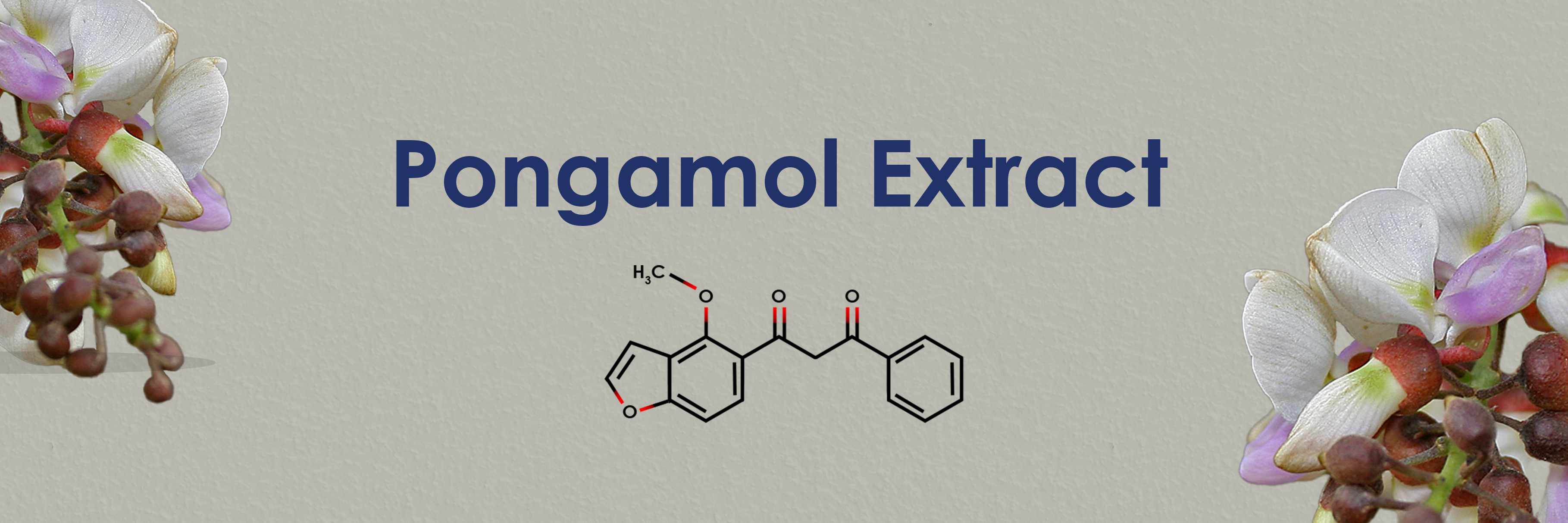INTRODUCTION
Pongamol is a naturally occurring flavonoid primarily extracted from the seeds and leaves of the Pongamia pinnata tree (also known as Karanja tree), native to South and Southeast Asia. It is a cream-colored compound that belongs to the flavonoid family and is known for its antioxidant, anti-inflammatory, antimicrobial, and pesticidal properties. It is one of the key bioactive constituents of Pongamia oil.
MANUFACTURE
The extraction of Pongamol typically involves the following steps:
1. Mature seeds or leaves of Pongamia pinnata are selected and cleaned. The material is shade-dried and ground into a fine powder.
2. Solvents like ethanol, methanol, or hexane are used to extract Pongamol.
3. The extract is filtered, and the solvent is evaporated under reduced pressure to concentrate the Pongamol.
| Botanical name | Pongamia glabra |
| CAS no. | 484-33-3 |
| EINECS no. | 414-540-3 |
| Molecular formula | C₁₈H₁₄O₄ |
| Molecular weight | 294.3 |
| Structure |  |
APPLICATIONS
| Pharmaceuticals & Nutraceuticals: |
| • Shows anti-inflammatory, antioxidant, anti-cancer, and antibacterial activities. |
| • Potential therapeutic use in skin disorders, rheumatoid arthritis, and diabetes. |
| Cosmetics: |
| • Incorporated into skincare formulations for its antioxidant and anti-inflammatory effects. |
| • May help in reducing pigmentation and protecting the skin from UV-induced damage. |
| Animal Health: |
| • Used in veterinary formulations to treat skin infections and parasites. |
| Agriculture: |
| • Biopesticide and natural insect repellent due to its antifeedant and growth-inhibiting properties. |
| • Used in organic farming as an eco-friendly alternative to chemical pesticides. |
| Bioenergy Sector: |
| • Pongamol is studied for its role in biofuel production, particularly from Pongamia oil derivatives. |
| Test | Unit | Specification |
|---|---|---|
| Appearance | – | Cream color powder |
| Melting range | – | 126.0 °C – 132.0 °C |
| Loss on drying | % | NMT 3.0 |
| Assay (Pongamol by HPLC) | % | NLT 95.0 |
| Heavy Metals | ||
| Arsenic (as As) | ppm | NMT 1.0 |
| Cadmium (as Cd) | ppm | NMT 1.0 |
| Lead (as Pb) | ppm | NMT 3.0 |
| Mercury (as Hg) | ppm | NMT 0.1 |
| Microbiological anlaysis | ||
| Standard plate count | cfu/g | NMT 1000 |
| Yeast & Moulds | cfu/g | NMT 100 |
| Escherichia coli | – | Should be absent |
| Staphylococcus aureus | – | Should be absent |
| Salmonella | – | Should be absent |
PACKING
25 kg HDPE drum.
STORAGE
Store at cool, dry place away from light & moisture.
CERTIFICATIONS
GMP, FSSAI, HALAL
ExSyn offers Pongamol extract on commercial scales and welcomes enquiries. Our exceptional quality and service will make ExSyn your supplier of choice! If you need any additional information or SDS, please contact us.
5-Methyl-3-vinyl-2-oxazolidinone (V-MOX) is a highly reactive monomer valued for its low viscosity, mild odor, and excellent reactivity. It is widely used as a reactive diluent in UV-curable inks and coatings, where it enhances adhesion, produces brighter colors, and improves safety compared to conventional diluents. In addition, V-MOX serves as a key building block in the synthesis of kinetic hydrate inhibitor (KHI) polymers, which are applied in oil and gas production to prevent hydrate blockages in pipelines.
Zinc ricinoleate is the zinc salt of ricinoleic acid, a hydroxylated fatty acid derived mainly from castor oil (Ricinus communis). It appears as a white to slightly yellowish powder, waxy solid, or paste, depending on formulation. Its most valuable property is its ability to trap and absorb odor molecules such as amines, sulfides, and short-chain fatty acids, making it an essential ingredient in deodorant and odor-control products.
2-(tert-Butyl amino)ethyl methacrylate (TBAEMA) is a functional methacrylate monomer that contains a secondary amine group and a hydrophobic tert-butyl moiety, giving it excellent versatility in pH-responsive and adhesion-enhancing polymer systems.
It is valued in printing ink formulations for its ability to enhance adhesion, flexibility, and surface interaction.
Commonly known as potassium bis(fluorosulfonyl)imide (KFSI), the compound has a three-carbon backbone bearing six fluorine atoms and two sulfonimide (-SO₂F) groups. The molecule’s architecture lends it both high chemical stability and useful reactivity. Because of its excellent ionic conductivity and thermal / electrochemical stability, it finds use in advanced electrolyte formulations—for example in lithium-ion and next-generation batteries, in ionic liquids, and in other electrochemical systems.
Colchicine is a naturally occurring alkaloid obtained primarily from the autumn crocus (Colchicum autumnale) and related species. It has been used in medicine for centuries, especially for the treatment of gout and Familial Mediterranean Fever. In modern medicine, Colchicine is valued also in conditions like pericarditis, Behçet’s disease, and certain dermatological and cardiac disorders.
1-Butylimidazole is a versatile organic heterocyclic compound belonging to the imidazole family, where a butyl group (–CH₂–CH₂–CH₂–CH₃) is attached to the nitrogen atom at the 1-position of the imidazole ring. Its applications span organic synthesis, materials science, and bioactive compound development due to its tunable physicochemical properties and structural versatility.
Atropine sulfate monohydrate is a chemical compound, specifically a salt of atropine and sulfuric acid, with one water molecule (monohydrate) attached. It is commonly used as a medication and in research due to its anticholinergic properties, meaning it blocks the effects of acetylcholine at muscarinic receptors.
4-Aminobenzoic acid, commonly abbreviated as PABA, is an aromatic amine and carboxylic acid compound. It consists of a benzene ring substituted with an amino group (–NH₂) in the para position to a carboxylic acid group (–COOH).
2-Amino-5-Nitrophenol (5-NAP) is an organic compound with the molecular formula C₆H₆N₂O₃. It is a substituted phenol with both an amino group (-NH₂) and a nitro group (-NO₂) attached to a benzene ring, along with a hydroxyl group (-OH).
